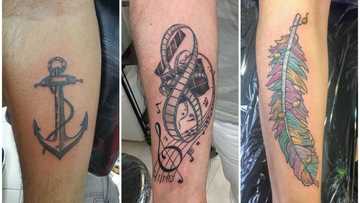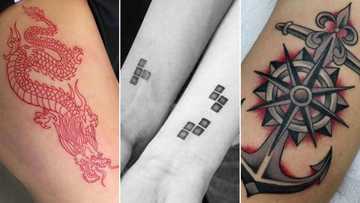Is a septum piercing painful? Here is all you need to know about getting one
Septum piercings, which go through the cartilage between your nostrils, have increasingly become mainstream. They were once only associated with punks and cartoon bulls but have become popular partly because celebrities sport them. Are you toying around with the idea of getting a septum piercing? Here is everything you need to know.

Source: UGC
TABLE OF CONTENTS
- What is septum piercing?
- Can anyone get a septum piercing?
- Why do people get their septum pierced?
- What does a septum piercing mean for a woman?
- Is a septum piercing very painful?
- How a septum piercing is done
- Ideal septum piercing healing time
- How risky is a septum piercing?
- Signs and symptoms of an infected septum piercing
- Septum piercing aftercare guidelines
- Why does my septum piercing smell?
- How to clean septum piercing
Piercings offer a fun and reversible option to change your appearance and self-expression. Unlike the steel hoops of the past, contemporary septum piercings are simple, subtle, and favoured by celebrities like Zendaya and Florence Pugh. However, before going out of your way to get this stylish nose accent, here are expert insights into what to expect.
What is septum piercing?
A septum piercing is a form of body modification in which a hole is drilled through the fleshy tissue between the nostrils, called the septum. A piece of jewellery, such as a barbell or ring, is inserted into the piercing.
Historically, this form of body modification symbolized rebellion and nonconformity and challenged societal norms. Septum piercings have, however, gained popularity in art and fashion, and different jewellery styles are now available for personalization. Thus, most people use septum piercings as a fashion statement or a way to express themselves.
Can anyone get a septum piercing?
Pretty much. However, not everyone's septum has that thin strip of tissue in front of the cartilage (called columella). Ideally, piercers target this flesh for piercing because it is the sweet spot for this kind of aesthetic enhancement.
If this tissue is thin or completely absent, piercing through cartilage is still possible but is more painful and slower to heal.
Why do people get their septum pierced?
Most people get their septum pierced for various reasons. For some, it is a way to express one's identity, signify culture, enhance aesthetic appeal, or challenge societal norms. Others view it as a show of rebellion or a reflection of individual tastes and beliefs.

Source: Getty Images
What does a septum piercing mean for a woman?
Septum piercing meaning can differ among women depending on personal and cultural interpretations. In some cultures, a septum piercing signifies a rite of passage. It has also been traditionally associated with rebellion, individuality, or counterculture.
The meaning can be subjective depending on who you ask. However, it is a departure from traditional beauty standards, a trend in the evolving cultural landscape for many women. For others, a septum piercing represents strength and resilience.
Is a septum piercing very painful?
All nose piercings are painful, and septum piercings are no exception. The undesirable fact is that you're piercing through cartilage, which is more sensitive than regular skin. However, their pain scale ranks lower than other body piercings.
Contrary to popular belief, septum piercings are among the least painful. When performed accurately by an experienced professional, the piercing targets a soft area of thin skin, often called "the sweet spot." Avoiding nasal cartilage results in minimal pain. Some individuals experience a single tear, a normal reaction rather than intense pain.
But how much does it hurt? If the piercer accurately targets the sweet spot, the sensation is often described as strange rather than painful and is akin to the urge to sneeze. Some people find inserting the needle uncomfortable.
The consensus among artists is that staying relaxed during the procedure can minimize pain. However, the level of discomfort varies from person to person and is influenced by factors like the expertise of the piercer and the application of numbing agents.
How a septum piercing is done
The first step is to select a reputable piercer. Once your appointment is ready, the standard protocol is to provide your ID and complete paperwork, which includes signing a waiver. You will then sit on a chair to allow the piercer to disinfect the nostril area. The protocols may vary depending on the artist, but, as standard, they utilize:
- A needle (called the freehand)
- Forceps to hold the nostrils open
- A receiving tube to enhance symmetry
Your jewellery is then slipped into the piercing as the freehand needle is pulled out. The actual piercing process is pretty swift and typically takes a minute or two from start to finish. Regardless of the technique, the piercer observes strict sanitary and safety measures that include:
- The use of disposable sanitary gloves.
- Disinfection of the nostrils.
- The use of sterile needles and equipment.

Source: Getty Images
Ideal septum piercing healing time
The septum is a delicate part of the nose that often takes time to heal when pierced. Experts recommend that you refrain from interfering with the healing process. Changing the jewellery prematurely, for instance, can irritate and prolong healing time.
Typically, septum piercings heal fully in 4 to 6 months. However, substantial healing can be achieved between 2 to 3 months, provided that septum piercing aftercare guidelines are followed. How quickly and how well one heals will hinge on factors such as:
- Stress levels
- Immunity
- Adherence to aftercare regimes
- How little or how much you touch the piercing during the healing process.
How risky is a septum piercing?
A septum piercing carries several risks, primarily associated with allergies, infections, and improper healing. However, going to a skilled and reputable piercer can significantly reduce any potential risks. Cartilage damage can occur in rare cases, but the most common risks to consider include:
- Infections: Piercing your skin can induce bacteria into the body and lead to infections. This can cause swelling, redness, pain, and discharge.
- Bloodborne diseases: Using unsterilized equipment can cause bloodborne diseases such as HIV and Hepatitis. So, emphasize the need for a fresh, sterile needle.
- Scarring and tearing: The piercing procedure can cause scars, which can be painful. Moreover, jewellery can get caught up in the tissue and cause tears.
Signs and symptoms of an infected septum piercing
A piercing can sometimes exhibit adverse effects and even take longer to heal. It is recommended that you consult a healthcare provider if you experience the following signs and symptoms:
- Severe pain, redness, or swelling
- Itchiness or pressure
- Smelly pus or green discharge
- Skin eruptions or thinning
- Fever
- Formation of bumps around the piercing
Septum piercing aftercare guidelines
Proper aftercare is crucial to promote quick healing and prevent complications with your piercing. Piercers typically provide aftercare instructions for you to follow for septum piercing. Here are the do's and don'ts to bear in mind:
- Always clean your hands before you touch the piercing to avoid introducing bacteria.
- Use a saline solution to rinse your piercing area.
- Get dressed or blow your nose carefully to avoid scathing the piercing.
- Don't touch the piercing regularly, as it can prolong healing time.
- Don't flip your jewellery before the piercing is healed properly.
- Don't clean the piercing with alcoholic products or soaps that contain irritants.
Why does my septum piercing smell?

Source: Getty Images
Some individuals with septum piercings sometimes detect a noticeable odour, likely caused by dead skin cells and oils that accumulate around the bling. As expected, any foul smell will be more apparent, given the piercing is right under the nose. However, routine cleaning should manage the smell unless you have signs that point to an infected septum piercing.
How to clean septum piercing
Your piercer will provide aftercare practices to adhere to when cleaning your piercing. Here is the standard procedure:
- Clean your hands thoroughly.
- Soak a clean cotton pad in saline water.
- Gently apply it to the piercing. Remember not to rotate the jewellery.
- Allow the solution a few minutes to loosen the debris.
- Rinse the residue with warm water and pat the piercing dry with a paper towel.
- Do this twice per day, and avoid cleansers that contain harsh ingredients.
The decision to get a septum piercing boils down to personal choice. All it takes is to endure a brief discomfort you can manage with proper aftercare. Conduct your due diligence to select a reputable piercer and adhere to the appropriate aftercare regime.
Legit.ng recently published an article on various garden party attire ideas. Garden parties are one of those great occasions that bring people together. They can range from wedding events to casual outdoor gatherings or birthday parties.
The garden party dress code is fairly simple and something that will give you comfort. At times, the garden venue and weather of the day can dictate the attire one must wear. This should be a casual day, and your style choice should not be the focal point.
Source: Legit.ng









